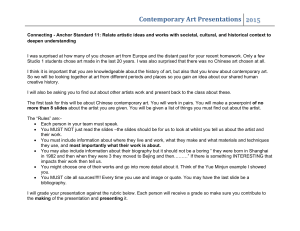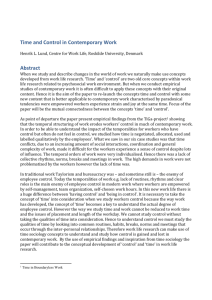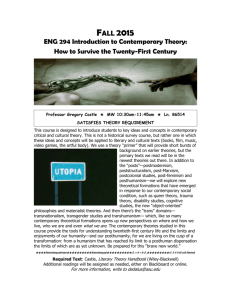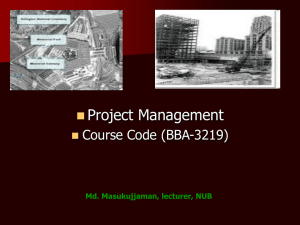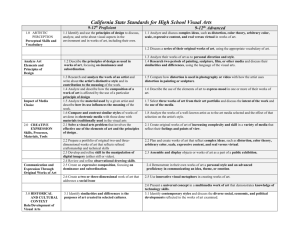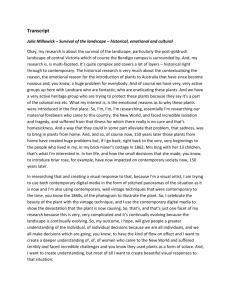Name: Tay Kai Lin Hilda Class: M10407 Date: 20/04/10 Word count
advertisement
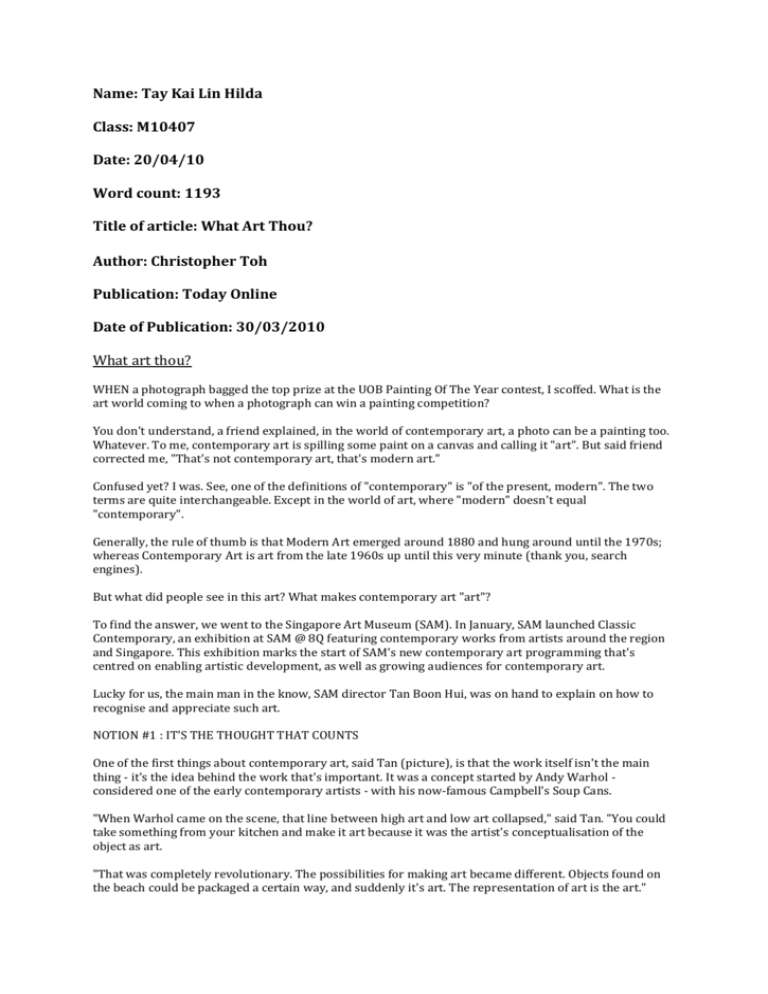
Name: Tay Kai Lin Hilda Class: M10407 Date: 20/04/10 Word count: 1193 Title of article: What Art Thou? Author: Christopher Toh Publication: Today Online Date of Publication: 30/03/2010 What art thou? WHEN a photograph bagged the top prize at the UOB Painting Of The Year contest, I scoffed. What is the art world coming to when a photograph can win a painting competition? You don't understand, a friend explained, in the world of contemporary art, a photo can be a painting too. Whatever. To me, contemporary art is spilling some paint on a canvas and calling it "art". But said friend corrected me, "That's not contemporary art, that's modern art." Confused yet? I was. See, one of the definitions of "contemporary" is "of the present, modern". The two terms are quite interchangeable. Except in the world of art, where "modern" doesn't equal "contemporary". Generally, the rule of thumb is that Modern Art emerged around 1880 and hung around until the 1970s; whereas Contemporary Art is art from the late 1960s up until this very minute (thank you, search engines). But what did people see in this art? What makes contemporary art "art"? To find the answer, we went to the Singapore Art Museum (SAM). In January, SAM launched Classic Contemporary, an exhibition at SAM @ 8Q featuring contemporary works from artists around the region and Singapore. This exhibition marks the start of SAM's new contemporary art programming that's centred on enabling artistic development, as well as growing audiences for contemporary art. Lucky for us, the main man in the know, SAM director Tan Boon Hui, was on hand to explain on how to recognise and appreciate such art. NOTION #1 : IT'S THE THOUGHT THAT COUNTS One of the first things about contemporary art, said Tan (picture), is that the work itself isn't the main thing - it's the idea behind the work that's important. It was a concept started by Andy Warhol considered one of the early contemporary artists - with his now-famous Campbell's Soup Cans. "When Warhol came on the scene, that line between high art and low art collapsed," said Tan. "You could take something from your kitchen and make it art because it was the artist's conceptualisation of the object as art. "That was completely revolutionary. The possibilities for making art became different. Objects found on the beach could be packaged a certain way, and suddenly it's art. The representation of art is the art." In other words: I think, therefore it's art. NOTION #2 : THE ARTIST DOESN'T ACTUALLY MAKE THE ART No, contemporary artists don't always make their own art. They essentially conceive the idea and act as director to a bunch of hired artisans and craftsmen, who are the ones who actually put the piece together. "But while this practice may be frowned upon in other art periods, in the contemporary art period, that's all right," said Tan. "People like Jeff Koons, Takashi Murakami - they are (seen as) artists even though their works are not necessarily done by them. Why? Because it's the idea that counts." NOTION #3 : ANYTHING CAN BE ART, BUT NOT EVERYTHING IS Only in contemporary art can everything be depicted as art. "That is one of the most important features. Art does not have to look like 'art'. Even mass produced stuff is art," said Tan. But not everything can be contemporary art. "Marcel Duchamp's famous urinal, for example, isn't seen as contemporary art because he still signed his urinal and the urinal was a particular urinal made only from a particular factory," said Tan. "Whereas Warhol's can of soup could have been any Campbell's can of soup." An example is Simryn Gill's exhibit, Washed Up, a collection of broken glass, some sand-blasted with text and arranged to look like objects washed up on the beach. "How it's marked as art is the way she has sandblasted some of the glass pieces and how she has arranged the pieces. It reflects her feelings, as a traveller, with an almost emigre lifestyle, no permanent home. It has a lot of meaning for her," he added. NOTION #4 : ARTISTS TAKE ISSUES WITH ART Another key component: Almost every work of art is a commentary about the artist's feelings and stance on issues, whether societal or personal. "The motivation of the art comes from the artist wanting to confront, show and raise debate about issues that they feel is important at the time," shared Tan. Money Suit by Singaporean Vincent Leow, for example, features a suit made up of fake dollar bills, and is a dig at society's obsession with materialism and pursuit of wealth. Vietnamese artist Vu Dan Tan's Beauty Will Save The World, a series of cardboard boxes shaped into dresses, with no two dresses alike, is a commentary about "being able to be yourself in a society that tends to homogenise everything"; while Thailand's Chatchai Puipia's You Inside, Are You Still OK turns the famous Thai smile so often used in tourism ads into a grimace, "as if to say that while things may look nice and sweet on the outside, there are deeper undercurrents within," said Tan. NOTION #5 : CONTEMPORARY ART CAN BE 'OLD' Not all contemporary art needs to be modern-looking. Cambodian Sopheap Pich's Cycle uses a traditional Cambodian cane-weaving technique to form a sculpture. "The use of this everyday material is only found in contemporary art," said Tan. "So, not all contemporary art is about video or new material, traditional elements can be used too, in a completely different way." NOTION #6 : KNOW THE ARTIST, KNOW THE ART According to Tan, unlike other forms of art, it's essential to have some knowledge of the artist in order to "get" what he or she is trying to say. For instance, Indonesian artist Handiwirman Saputra's piece Cemani, Telur, Tai Kapur (picture) features a giant egg and, perched a couple of feet above, a small black taxidermied chicken eyeing the egg. "If you know where (Handiwirman) came from and the culture there, you'll understand why he did it this way. The bird is looking at the egg like: 'Do we really want it that big?' "That's why you'll find that we've given a short writeup about the artist and background to the piece being exhibited. It helps a lot." NOTION #7 : YOUR OPINIONS TRANSFORM THE ART Nevertheless, as with art, you're also free to form your own opinions, Tan continued, recalling an incident where a five-year-old commented that Handiwirman's egg was a dinosaur egg. "That changes the whole thing," said Tan. "Is the bird now looking at the egg like it's remembering a past long gone?" Although he said that it's the younger crowd that seem to better appreciate contemporary art, that doesn't mean that those over 30 can't. "The spirit of contemporary art is that you're no longer trapped by the rules of how art mediums are used," said Tan. Which would explain how a photograph won Best Painting. All this, of course, has inspired me to come up with my own project. I'm going to get my colleagues to clean out all the unwanted stuff on my desk, and arrange it into separate piles for recycling. It's reflecting my stance on the renewal of self. You call it spring cleaning, I call it Art. --------------------------------------------------------End of article------------------------------------------------------------ Summary Scoffed at the fact that a photograph won a painting contest, the world of art was felt to be degrading. However in contemporary art, a photo is considered to be a painting, but begging to differ, one may feel that it was painting on a canvas, but others pointed out that it was instead modern art. However contemporary and modern actually had similar meanings, except in art. At a Classic Contemporary exhibition at SAM, its director was explaining the steps to recognising contemporary art. The first notion was, it’s the thought that counts. The idea behind the work is seen as more important, and up to the artist’s conceptualisation to be called art. This increased the possibilities of art, and many daily objects could be felt as art. The second notion was, the artist doesn’t actually make the art, implying that artists has an idea and hire others to bring it out. Although most disagree, in contemporary art, these people are still seen as artists. The next notion was, anything can be art, but not everything is. Contemporary art pictures everything as art, even though it does not look like one. Depicting Simryn Gill’s exhibit as art with the way she glazed glass pieces with sand, reflecting her feelings and lifestyle, bringing out meaning. The fourth notion would be that, artists take issues with art. Art comments on the feeling and stand of artists on issues, wherein motivation comes about. Also, the fifth be, contemporary art can be ‘old’ . it need not look new, and can comprise of traditions, making use of everyday things to compile. Adding on, the sixth notion is: know the artist, know the art. Knowing the artists would allow understanding of his thoughts, hence giving a write-up to art piece would help. Lastly, the seventh notion is that your opinions transform the art. With art, comes free opinions. Younger people seem to appreciate contemporary art more, but older ones can too. It is not just trapped in the rules of art, but freely expressed. Commentary Contemporary art has always been a distant topic to me. I previously had the same thoughts as the writer, not knowing the difference between contemporary art and modern art. However, these seven notions really were an eye-opener to un-artistic people like me. From the first notion, I came to a realisation that anything and everything in our everyday lives can be called art, just up to the artist’s conceptualisation. Art is a free topic in which its boundaries cannot be named. The next notion enlightened me that artist’s may not always be the one making the art, a huge sculpture can also be deemed as art, but others may be the one making it, giving the effort to the artist. Adding on, the third notion ensured me that it is the perception and creativity that makes an artist what he is, putting together everyday items and bringing out different feelings in them, is what real art is about. Also, the next notion shows me that every artwork would have a hidden story behind its idea and what motivated the artist to come up with such a piece. Art can also be made from old and traditional things, bringing out meaning in them, it need not be all modern and new, ‘old’ can also be considered as good too, showing what I learnt from the fifth notion. The sixth notion also taught me that an impression about the artist can allow us to guess his way of thinking and style of making artworks, through this bringing out the importance and meaning the artist is trying to convey with the art piece. The last notion shows how our imagination can run wild with art. Art knows no boundaries, hence with it we will have different impressions and opinions about the same thing, allowing one to freely express his feelings with art.
